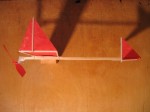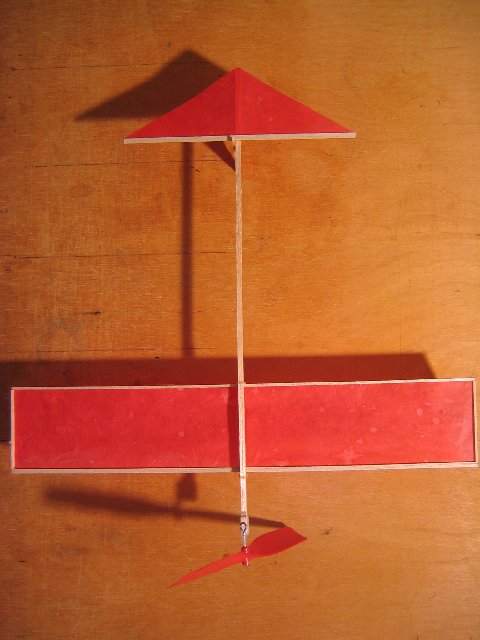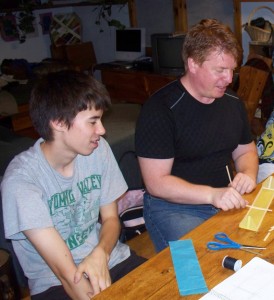Here’s a video and some comments I got from Gary:
I have only the one video of the Squirrel. I didn’t get the whole 1:02, I was launching the plane in the first few seconds with the camera dangling from my wrist. I just looked at your one winglet stall video again and mine starts the same way; zooms, falls off, may hit the floor, may zoom again and fall off, eventually settles into a steady left circle. I prefer a slow, steady climb. It will do that with lower torque from a thinner motor. I think I have too much decalage. Question is , how much should it have? Tough to experiment. Each angle requires a new stick and tail assembly. I will build a separate tailplane unit and test different tail incidences with shims. The difficulty is that when trimmed for slow glide, it zooms, but when trimmed for power, it dives in the glide. It needs trim conditions where CG agrees in power and glide.
One winglet is easy to investigate. Make one of each wing and fly them. There is a lot going on with the winglet. We had a lengthy discussion about it. Position relative to CG, direction of lift vector, blanketing by wing, effect of winglet on wing lift, interaction with fin, on and on. You can discuss all you want, a simple test will give a definitive answer. In consideration of all the above, I now think the left winglet would be the more effective. It is more likely to produce a lift vector above the CG and is not blanketed by the wing. It does interfere with the flow around the wingtip a little. Or they could be about the same. I am not a fan of one winglet. I guess I have classical Greek aesthetic preference for symmetry. (Says the expert on asymmetric kites. Hmmm, wonder if I could get one of those asymmetric kites flying with a rubber band.)
I am building another airplane today, an AMA Cub reduced for a 100 mm prop, using foam for the flight surfaces. So far the guys have made them too heavy at 5.5 grams. Mine will be 3.7, still too much, but with lighter foam later it may be OK. So I won’t get back to the Squirrel until later. It’s just as well to give it time, the longer I think about it, the more ideas I have.
Gary
I answered:
I’m spending a lot of my time helping people so my hands are often too busy to get good videos. I’m glad I get cool videos from guys like you.
When I make my Squirrels, I just have the tail at zero degrees to centerline of stick.
I then use a shim as it’s much easier when I do workshops to keep the number of steps down for construction.
I think I will make a removable winglet and move it back and forth on the same model. That will give me better quality information.
I make them with removable winglets to fit in my briefcase. So I’ll just use one of those I guess and see what happens.
I will try and get some outdoor flying in tonight.
I am thinking that your wing is symmetrical except for the shim block. If the shim block could be on a separate wing mount, you could just turn the wing around. My wing is not symmetrical because the trailing edge is thinner than the leading edge. A removable winglet is a good idea, too. I might be able to do that with the plain wing I have. The weight of the left winglet will accelerate the left sideslip, another factor to consider.
I was thinking to break and reglue my plain wing to make dihedral. Better wait on that until I get to test removable winglets.
I find that the Squirrel uses so little material, I like to have a few flying. Especially for outdoor as they get damaged and I fix them over and over.
I will post a video of the folding removable winglets later so you can see how easy it is to get that working…
I was thinking a second rib just inside the tip with enough space to be a firm friction grip on the fin, the fin being another wing rib with the winglet spar and paper glued to it. Adds the weight of two wing ribs.
I tried that in I couldn’t get a good friction fit. The winglet kept popping off. Wait till you see the video of the pop up winglets. There is a picture I think in the news section but I can’t remember.
I’ll go take a video of my removable winglet system now. It will take an hour or so by the time I have a some rum and transfer my camera to my computer and upload it all to youtube but I’m sure you will like it.


















